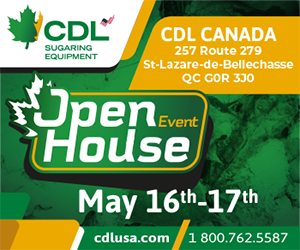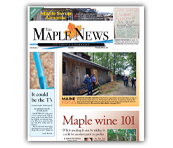BACK TO HOME
Tapping & Tubing
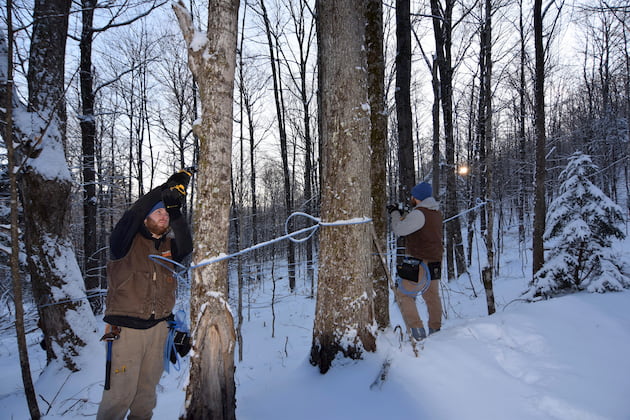
Avoid stained wood when tapping
Peter Gregg | August 6, 2020
NEW CASTLE, Ind.—Sugarmakers are encouraged to use longer drops, shallower tapholes and spend more time looking for good tapping surface when they begin tapping for the 2021 season.
That's the message from University of Vermont Extension maple specialist Mark Isselhardt when he spoke to Indiana producers during the annual meeting of the Indiana Maple Syrup Producers Association in New Castle, Ind. last winter.
“You will get 75 percent less sap if you tap into stained wood,” Isselhardt said.
Indiana sugarmakers who tend to use sap bags or buckets rather than pipeline in their flat woods are better suited to spend time seeing how each tree is producing.
“On buckets you know what each tree is doing whereas on tubing it all blends,” he said. [ MORE ]
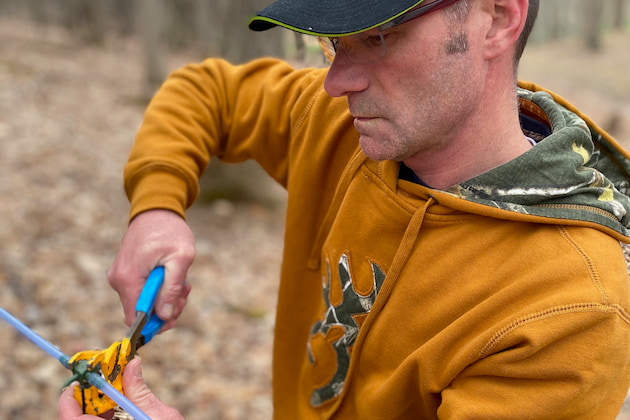
Sugarmaker shares experiences with 3/16 tubing sanitation
Brandon Daniels, CDL West Virginia & Virginia | July 22, 2020
DAWSON, W.V.—There has been much discussion and some research given to 3/16” and the reduction in flows that most see after the first season.
The information in this article will not be referred to as research, but it will be presented to help maximize your production on 3/16” tubing in seasons two through ten.
Before we jump into that, I will provide a little more information on our facilities and my background.
I started producing maple syrup over thirty years ago with a 2x3 stainless pan in the back yard and ten taps as a young teenager.
This has grown to a modern state of the art operation.
I am running 2,400 taps +/- 10 on 3/16” tubing in five different areas. These taps run into round bottom stainless tanks produced for maple sap.
In all of the areas we have taps, they are within approximately 1.5 miles of each other.
In all five of these locations, there are taps on slopes that face more than one direction and on the 2,400 taps, we have taps that face every direction on the compass. [ MORE ]
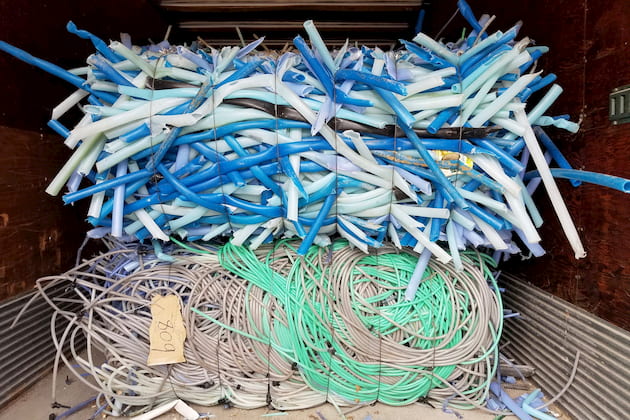
Sapline and spout recycling program in Northern Vermont
Richard Backer, Northwest Vermont Solid Waste District | May 26, 2020
GEORGIA, Vt.—Sugarmakers can recycle old tubing this spring instead of throwing it out with the trash.
The Northwest Vermont Solid Waste District (NWSWD) operates a small Material Recovery Facility (MRF) located at its administrative office adjacent to the Interstate 89 - Exit 18 interchange in Georgia, Vt.
The district is a municipally chartered organization fully serving 19 towns in Grand Isle and Franklin counties. NWSWD has an ongoing modest program to recover and recycle HDPE sapline.
Small and large syrup producers and county associations are encouraged to call NWSWD with inquiries or questions on recovery and recycling HDPE sapline.
Please call NWSWD at 802.524.5986.
If the sapline is clean, without contaminate plastics including spouts, tees or PVC we will take tubing from anyone in the state.
Sugarmakers in other states are welcome to bring their tubing to us as well, as long as it's clean.
[ MORE ]
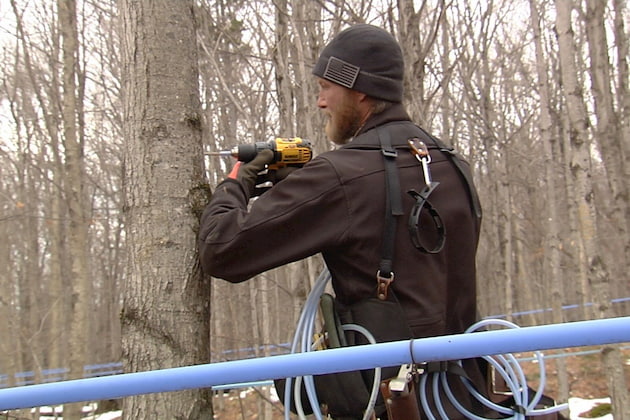
Vermont sugaring experts offer tapping tips
Peter Gregg | March 3, 2020
UNDERHILL CENTER, Vt.—Town Meeting Day in Vermont, this year March 3, has traditionally been the day sugarmakers get back in the woods to start tapping.
While that old adage is not as true as it once was, with most bigger operations tapping in January or February, many sugarmakers will be out drilling this week in Vermont and across the U.S. Maple Belt.
Meanwhile, industry experts from Vermont were on the pre-season meeting circuit this winter touting good tapping practices.
“Proper tapping is critical,” said Dr. Timothy Perkins, director of the Proctor Maple Research Center as part of the University of Vermont.
[ MORE ]
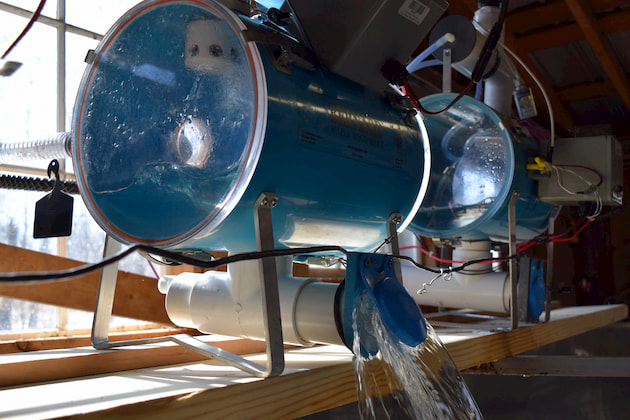
UVM compares 3/16” and 5/16” tubing sanitation
T.D. Perkins and A.K. van den Berg, University of Vermont Proctor Maple Research Center | January 3, 2020
UNDERHILL, Vt.—It is well recognized that microbial contamination of tubing systems can result in a substantial loss in sap yield if untreated.
Over a decade of research and maple industry experience has produced a range of possible strategies to address sanitation-related issues in 5/16” tubing systems (Perkins et. al. 2019).
Although rapidly adopted by many maple producers, due to the relatively short time period in which it has been in widespread use, there is far less understanding of sanitation in 3/16” tubing systems (Wilmot 2018).
To address this knowledge deficit, we conducted a multi-year study at the UVM Proctor Maple Research Center to examine sanitation-related losses in 3/16” tubing systems to determine which approach(es) might best mitigate sap losses due to sanitation. [ MORE ]
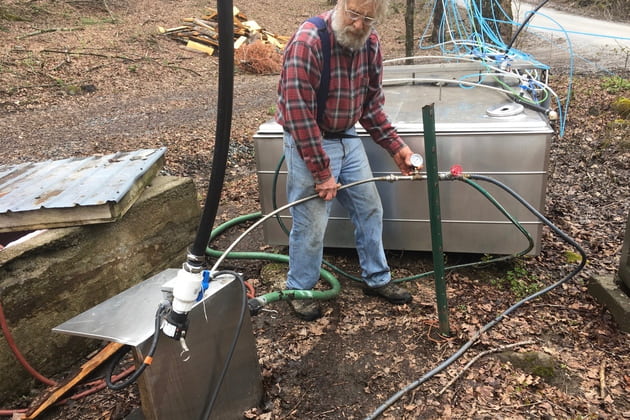
Sugarmaker weighs in on cleaning 3/16 tubing
Arthur Krueger | August 4, 2019
SHREWSBURY, Vt.—He are my 2019 observations on Calcium Hypochlorite bleach for cleaning 3/16” sap tubing at our sugarbush in Central Vermont.
After the 2018 season we cleaned our 3/16” tubing system with calcium hypochlorite bleach. This bleaching solution is made by adding 1 pound of “Zappit” Cal-Shock 65 to 200 gallons of water.
On 80 percent of the sugarbush we cleaned the system by pumping up air and the bleach solution through the laterals. Later we cleaned the drops by squirting bleach solution into the spouts using wash bottles.
These spouts were either replaced with new spouts or used bleached spouts for 2019.
(I found that it is possible to easily reuse a 3/16” fitting by boiling it and removing the bit of attached tubing with pliers. The fitting is not damaged by this treatment and is able to maintain high vacuum. We found no difference in performance between these used bleached spouts and brand new spouts.) [ MORE ]
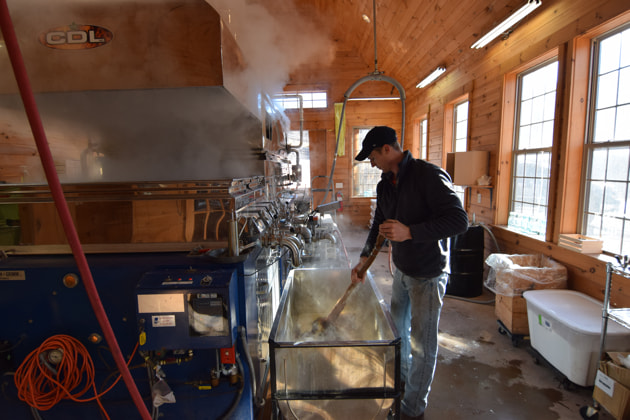
November tappers might go again
Peter Gregg | October 25, 2018
HOBART, N.Y.—With the calendar turning to November, some sugarmakers are getting ready to start their season.
“We might do about 2500 next week,” said Ben Holscher of Roxbury Mountain Maple in the Catskills region of New York.
Last year the Holschers tapped November 15.
Their effort was not necessarily part of a “fall tapping” experiment, but rather to get a very early start on the 2018 sugaring season.
“We’ve been tapping earlier and earlier in January anyway,” said Ben Holscher, 28, one of eight siblings in the Holscher family. “So what’s it going to hurt going a month or so earlier than that? Might as well.”
“Yeah, it’s been weird,” said Dave Holscher, family patriarch, during a boil last Dec. 6. “We’ve had better sap weather the past three weeks then we did all last year during sugaring season.”
In their valley, November and early December gave them a long three week stretch of perfect freezing nights in the 20s and daytime highs in the 40s.
Trees were gushing.
[ MORE ]
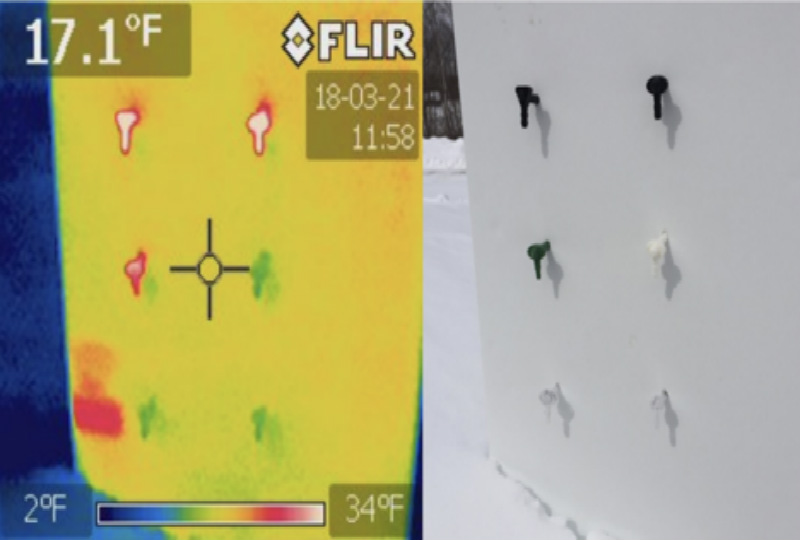
Spout color – Does it matter?
Dr. Timothy D. Perkins, Abby van den Berg, Mark Isselhardt, Brian Stowe and Wade Bosley | Sept. 28, 2018
UNDERHILL CENTER, Vt.—Among the many things that are debated in the maple industry, the effects of spout color on sap yield seem to have as many opinions as there are colors in the rainbow.
Spouts from maple equipment manufacturers are now available in a wide range of colors. Often this selection of color is simply a tool for large-scale producers to keep track of different tappers by assigning them a color, but producers also want to know if spout color has any effect on sap yield.
There has not been a lot of recent research on the subject. Centre Acer conducted a study a few years ago, which concluded that white spouts produced 7% more sap than black spouts (as reported by CDL in their 2018 equipment catalog, page 10).
However, there is likely to be variation from one year to the next depending upon the weather regime experienced during each season. Other factors such as spout design, manufacture, and overall spout/tubing sanitation levels are also likely to slightly affect the results.
[ MORE ]
















